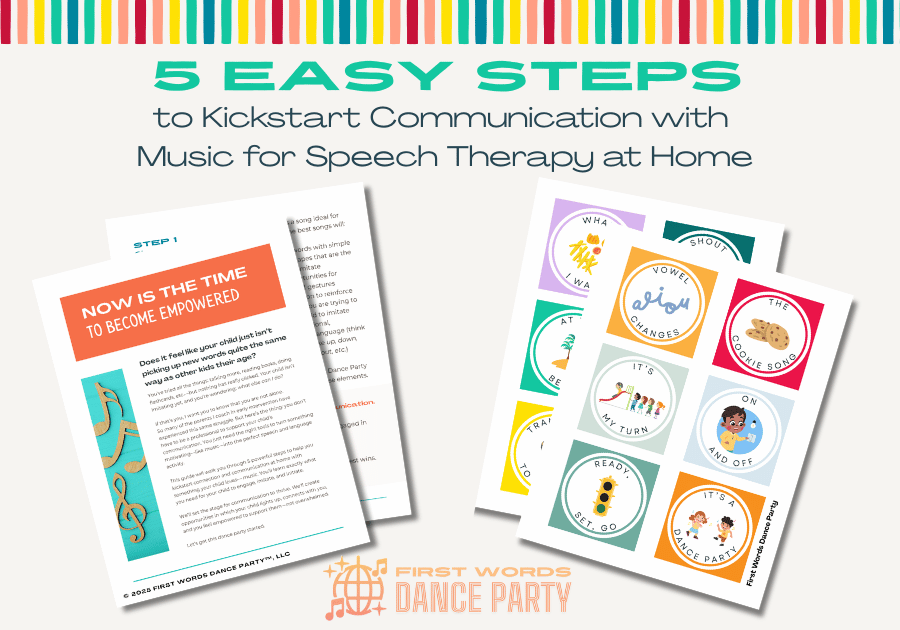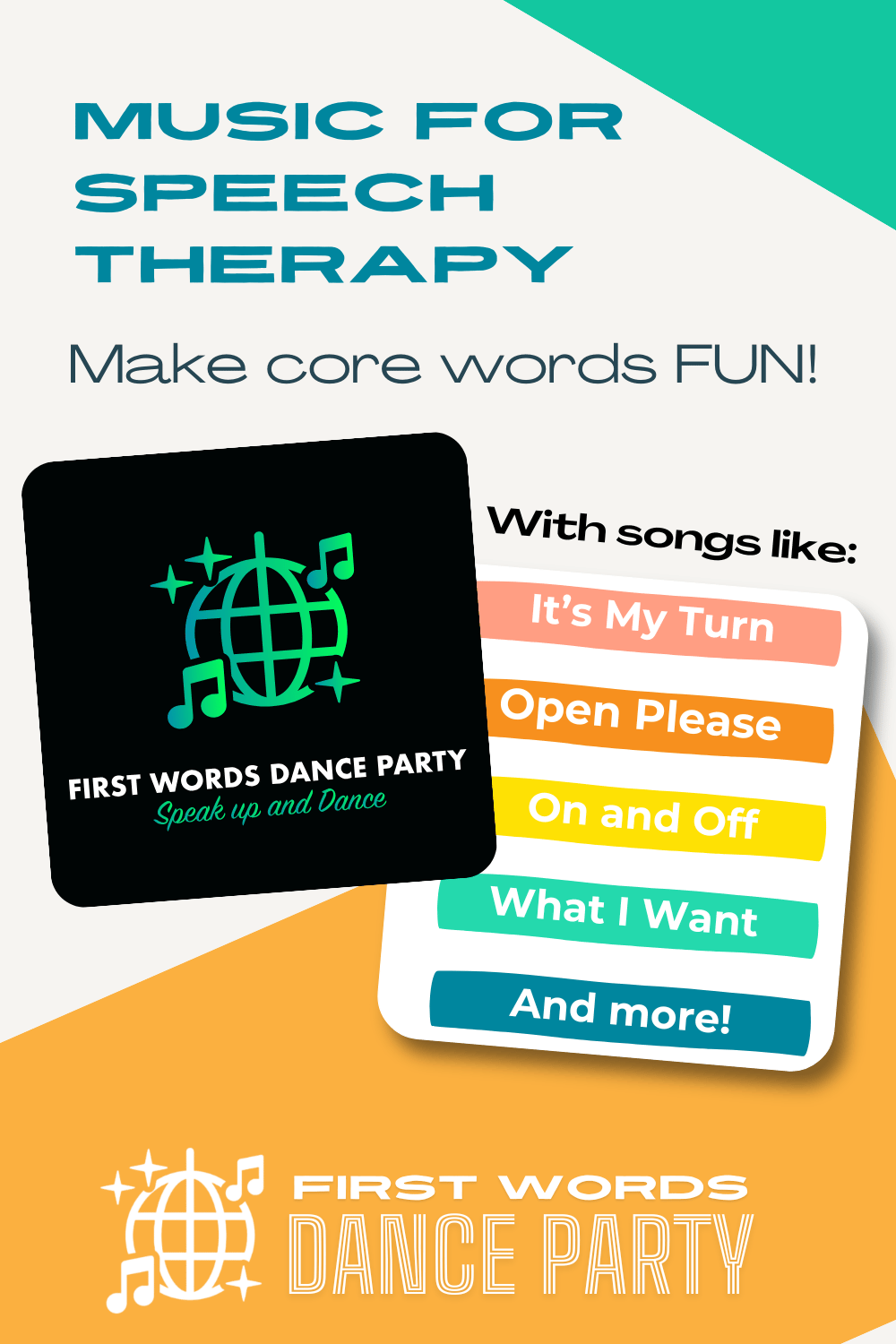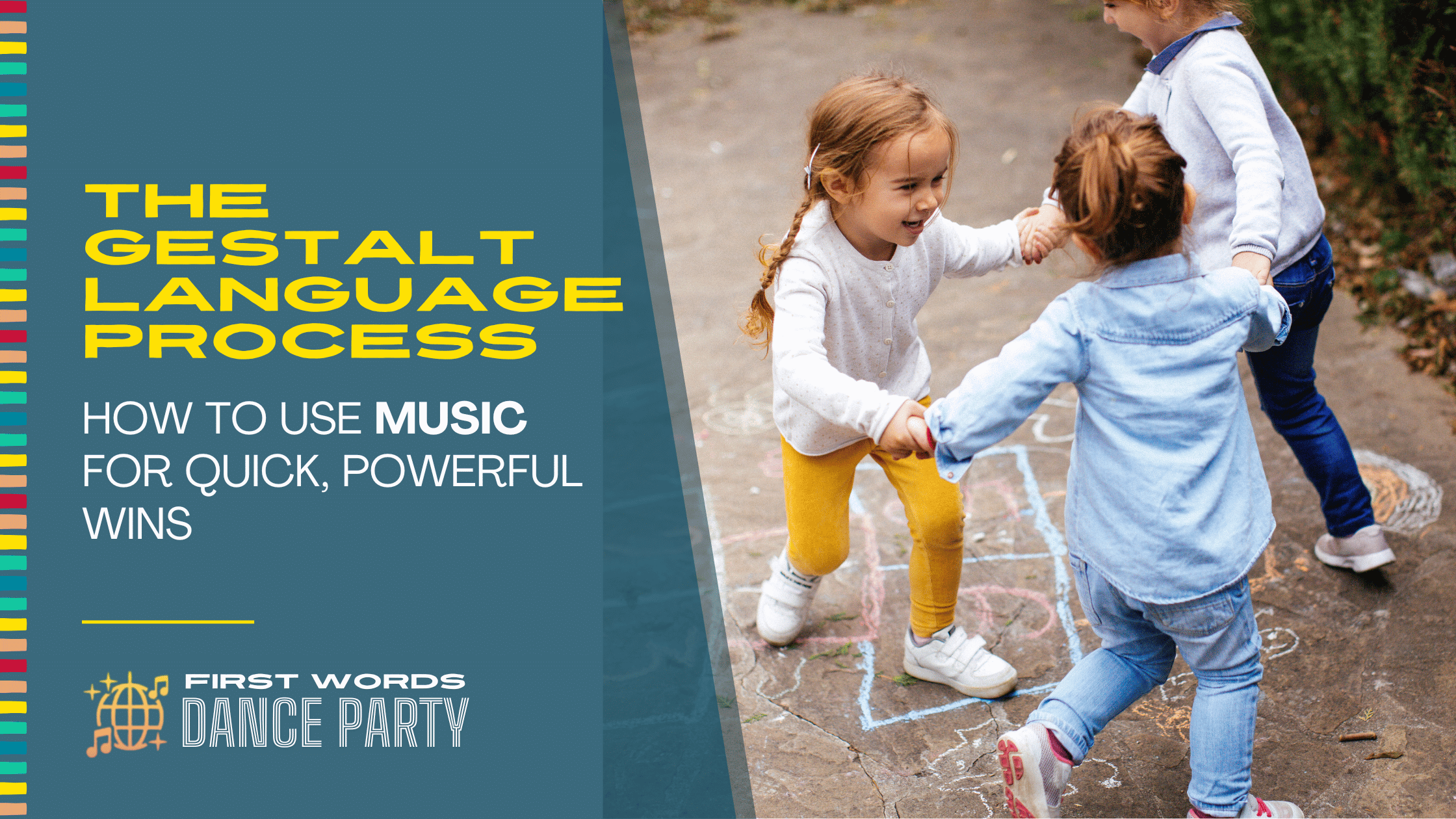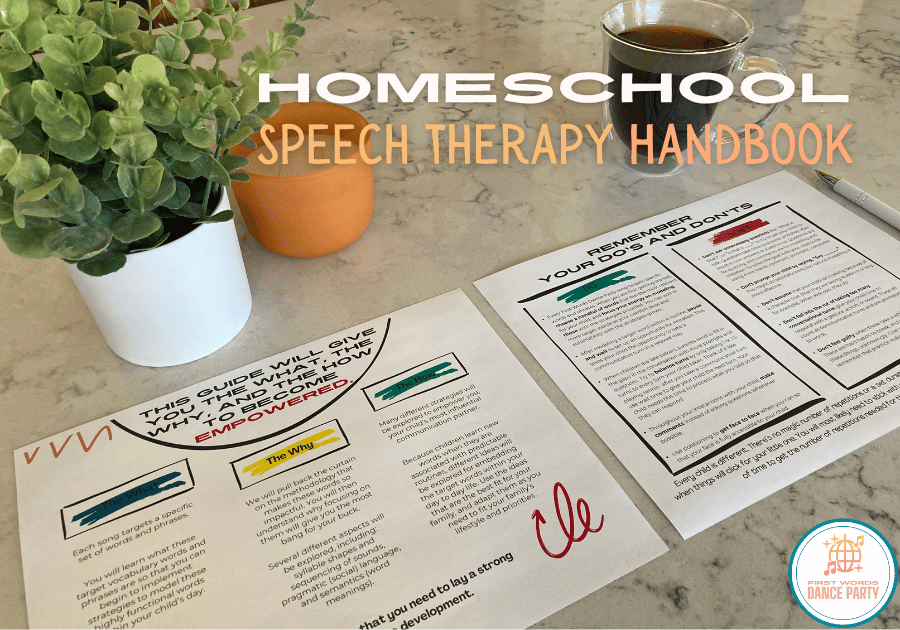How to Leverage the Joyful Nature of Music to Easily Teach Core Vocab
- Core Words
- 0 comments
Let’s talk about core vocab—that small group of everyday words that pack a big punch when it comes to communication. If you’re the parent of a child with a speech delay or a language disorder, then these are the kinds of words that are absolute game changers for language development.
You don’t have to be an expert to start focusing on core words, and music makes it easier (and more fun) than you might think.
Core vocab refers to high-frequency words like go, stop, want, need, in, on, and more—words that show up all day, every day. Core vocabulary is powerful because it can be used across lots of different contexts.
And the best part? You don’t need flashcards, a device, or structured drills to teach core language. You just need one simple tool that’s probably already part of your routine: music.
In this post, we’ll break down what core vocab is, why it’s such a game-changer for kids with speech delays or language disorders, and how you can use both well-known children’s songs and specialized music for speech therapy to model these words in ways that feel natural, easy, and effective.
If your child isn’t using many words yet, you may be unsure of what to do and what not to do- and you’re not alone. Many parents I coach in early intervention feel stuck, frustrated, or overwhelmed when their child won’t imitate their words.
That’s why I started creating music for speech therapy that weaves in the strategies we use everyday in early intervention.
You can download a free guide to discover 5 easy, parent-friendly steps to use songs for speech therapy to spark connection and communication with your child. As a bonus, you’ll receive song boards with cards for every First Words Dance Party™ song, so your child can make choices and initiate.
Let’s get into what makes core vocab so beneficial and how you can take advantage of it with the music your child loves.
What is core vocab, and why does it matter?
Core vocab refers to a small set of powerful words that account for the majority of what we say every day—words like want, go, stop, more, open, and help. These aren’t specific nouns like cookie or truck, but rather high-frequency words that can be used across all kinds of situations and activities.
Why are they such a big deal? Because research has shown that core words make up 50–75% of the words we use in everyday communication. These words give children the ability to make requests, ask questions, reject something, comment, and many other functions.
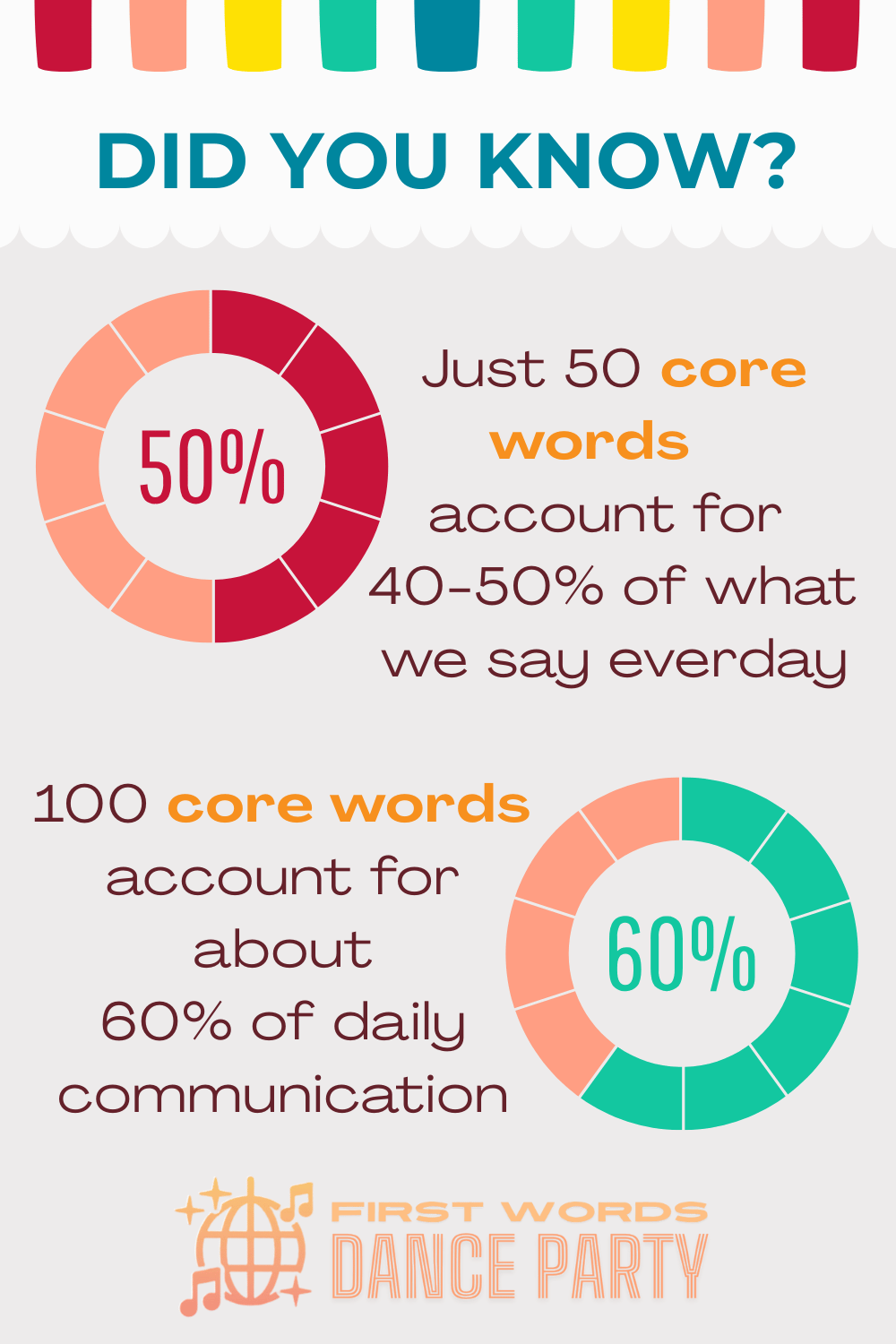
In a nutshell, core vocab opens the door to functional language. You can read more about what core words are and how to target them in everyday interactions with your child in this article.
Examples of core language
Curious for more core word examples? Check out the 100 High-Frequency Core Word List from AAC Language Lab—it’s a fantastic, parent-friendly visual guide to the core vocab your child is likely to hear and use each day:
🔗 100 High-Frequency Core Word List – AAC Language Lab
Are core words AAC exclusive?
While core words are often modeled with AAC devices, they are not exclusive to AAC- and you don’t need a device to start. You can model them verbally, with gestures, with signs, or by pointing to printed visuals like core boards.
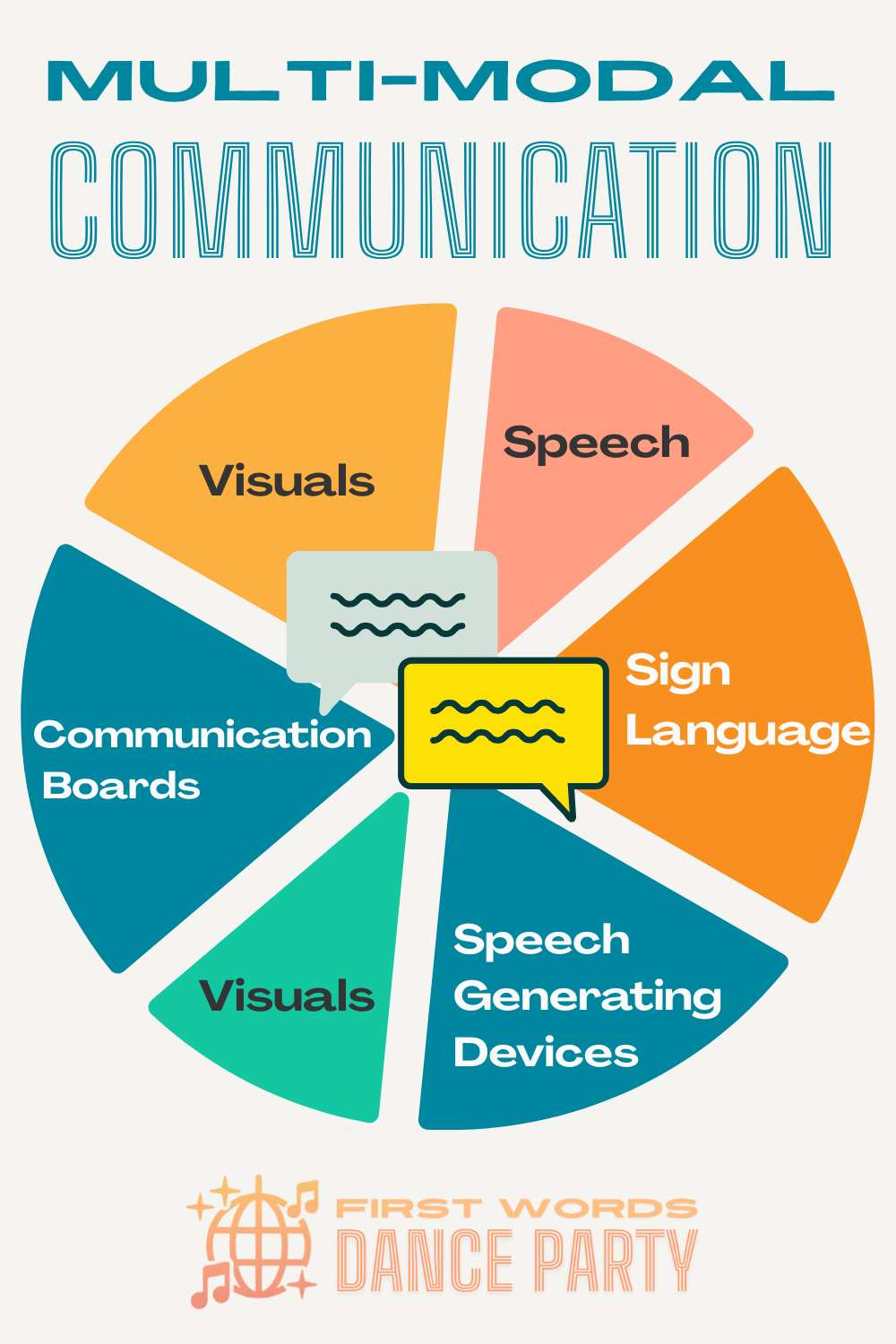
This is part of what’s called multi-modal communication—offering children multiple ways to understand and express language. It’s also a key part of total communication: creating opportunities for kids to connect using any and all methods available to them.
And music is a perfect way to do just that.
Why music helps kids learn core vocabulary
There’s a reason your child lights up and stops what they’re doing when they hear a favorite song starting—music activates the brain in ways that speech alone cannot.
For children with speech delays or emerging communication skills, music isn’t just fun. It’s a highly motivating tool for teaching.
Research demonstrates that music strongly supports brain development and language processing—read more from Harvard Health.
You can model core vocab through music in ways that are natural, playful, and totally pressure-free. No need for drills or flashcards- just language in a natural, playful context that kids love.
Here's why music is such a natural fit
Repetition builds understanding. Song lyrics are usually very repetitive, and this gives your child multiple chances to hear and absorb the same words.
Rhythm and melody support memory. Research shows that pairing language with rhythm and melody can enhance recall and language processing.
Songs are predictable. When your child hears “Head, shoulders, knees, and…” they know “toes” is coming. This kind of predictability helps children anticipate language and builds confidence in using words themselves.
It boosts engagement. Music naturally grabs attention. Kids often stay engaged longer during songs, which gives you more opportunities to model words.

One family’s success story
Earlier this year, I was just starting to work with the family of a 24 month old toddler who wasn’t speaking much yet, but he had started to enjoy the “magic” of his family’s home pod. It was the cutest thing to see this little boy say, “Alexa!” to activate it, and then to say “Mister Sun” to request “Oh Mister Sun”.
You might know that song:
Oh Mister Sun, Sun
Mister Golden Sun
Please shine down on me
While singing along together, his dad and I put extra emphasis on the word “down” and added a gesture of pointing down enthusiastically. After a couple of times through the song, he began imitating the gesture.
The next week at our session, his dad excitedly shared that he had started to use that same pointing gesture while saying “Da!” when he wanted to be let out of his high chair.
Core words are so incredibly powerful.
Classic children’s songs that naturally model these words
Before we even get to specialized tools and intentional songwriting, let’s talk about the songs you already know. Many classic children’s songs already have core words within the lyrics. These familiar tunes are simple, repetitive, and naturally full of high-frequency words that are perfect for modeling.
Here are a few favorites that do the job beautifully:
-
“Wheels on the Bus”
Core words: go, up, down, open, all-
This song repeats key action words, offering tons of opportunities to model while pointing to visuals, using gestures, and modeling the different actions.
-
-
“The Itsy Bitsy Spider”
Core words: up, down, out, all, comeIts predictable flow and hand motions make it a natural fit for teaching prepositions.
-
“Twinkle, Twinkle”
Core words: little, how, what, you, are, up, inI love this song as part of a bedtime routine. It’s a short and simple song with the question words how and what.
-
“If You’re Happy and You Know It”
Core words: You, it, happy, sadPerfect for modeling basic emotion words. This one works well for modeling facial expressions and gestures because yes- those count toward multi-modal communication.
-
“Open, Shut Them”
Core words: open, little, big, your, please, no, thank you, fast, slowA core vocab goldmine. The motions and pacing of this song naturally invite participation and make it easy to use a pause-and-wait strategy for the different core words.
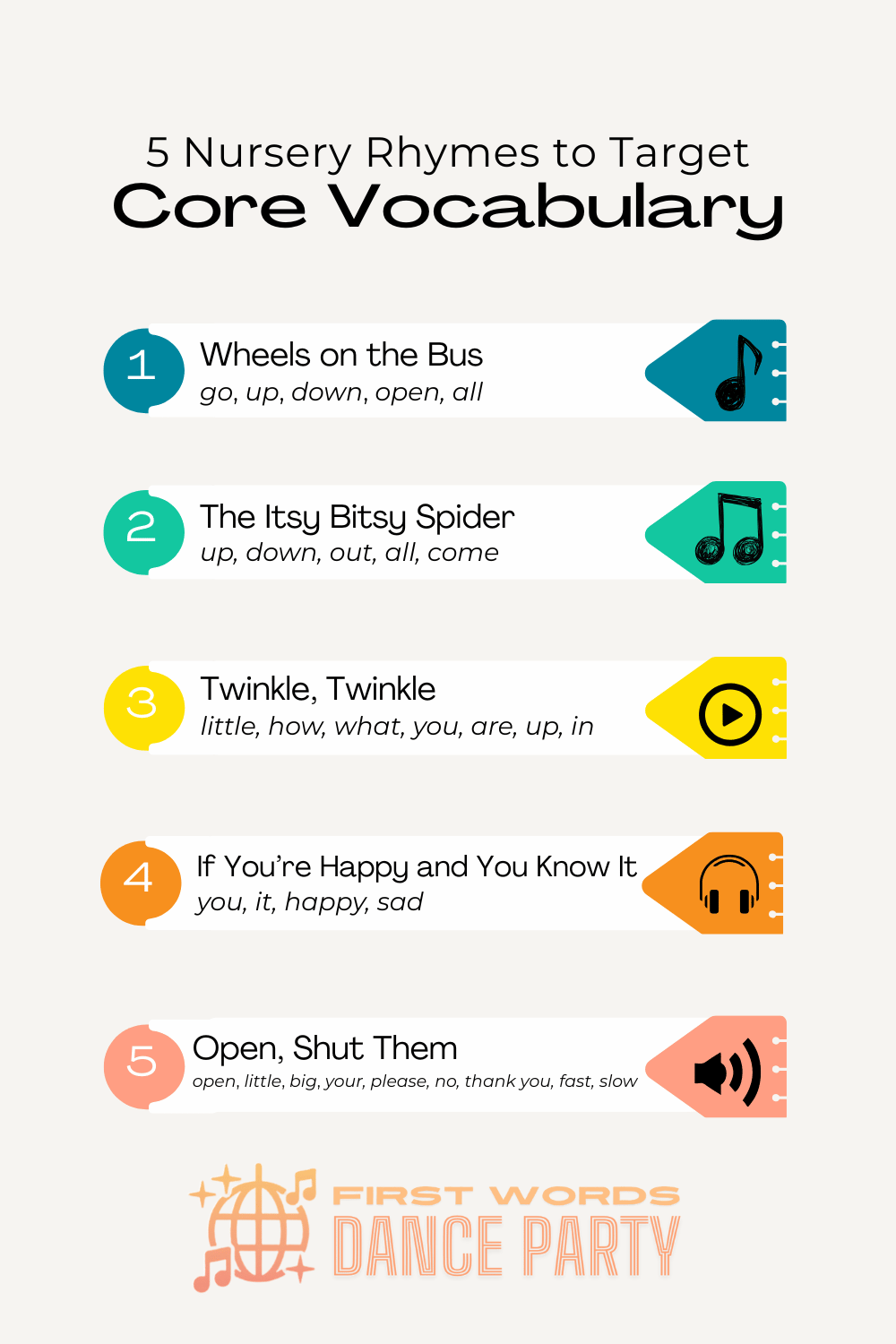
These songs are often already part of storytime, bedtime, car rides, or classroom routines—so take advantage of them!
And when you’re ready to go even deeper with more intentional vocabulary support, you don’t have to look far…
First Words Dance Party: Designed for Core Vocab from the Very First Beat
Classic songs are a great starting point, but let’s be honest—after singing them a million and one times, they can get a little old. It’s nice to change things up and discover some new tunes.
And given how powerful music is for speech and language development, having fresh songs to sing with our little ones can make a big difference.
That’s what inspired me to create First Words Dance Party—a collection of original songs written specifically to support early communication skills by modeling core vocabulary in fun, functional ways.
These songs were made with both kids and grown-ups in mind. They’re just as enjoyable for adults as they are for children, with catchy melodies, dance-y rhythms, and lyrics that reflect real-life routines and interactions.
Every single song was created to target specific core words:
“The Cookie Song” targets the words yes, no, eat, please, and I
“On and Off” (you guessed it!) highlights on, off, all done, turn, put, it
“What I Want” targets I, want, on, go, open, eat, and please
“Open” focuses on I, need, help, open, and please
Whether your child is starting to imitate, signing, or using AAC, these songs give you a playful, meaningful way to support their communication.
You can stream First Words Dance Party on Spotify, YouTube Music, Apple Music, and anywhere else you get your music.
How to Model Through Music
Once you know what core vocab is, and you’ve got great songs to sing—it’s all about how you use them. The magic is in the modeling.
Modeling core words means saying them with emphasis, signing, or pointing to them visually during everyday moments—without expecting your child to repeat them. It’s about showing them what communication can look and sound like, and inviting them into it over time.
We model without prompting children to imitate. Why? Because when we tell a child, “Can you say 'all done'?", or, “What is this called?”, it creates an unnatural break in the flow of communication.
And kids can easily become overly reliant on adults to prompt them, but our goal is for our little ones to use communication to initiate.

How to model core words with multi modal communication
Here are ways to model core vocabulary for AAC users and nonusers in lots of different ways.
-
Sing and model with intention
Emphasize the target word by slowing down, pausing before it, or repeating it. Example: “Down came the rain and washed the spider…out” -
Use gestures
Simple gestures and actions can do a lot to emphasize core words as you sing. This adds a visual layer that helps reinforce meaning. Adding gestures for “big” and “little” when you sing “Open, Shut Them” adds description that helps with comprehension. -
Point to visuals
Use low-tech printed visuals (like your free core word symbols) to point to the words as they come up in the lyrics. -
Pull in real items as props
Use toys or objects that match the song—like stuffed animals for “Old MacDonald,” or a tea set for “I’m a Little Teapot”. Real items help build connections and boost receptive language by tying words to tangible objects and experiences. -
Repeat with variety
See if you can get creative in changing the verses slightly. What other animals can live on Old McDonald’s farm? What if Old McDonald had a zoo? What if you used your child’s name instead? “Little JJ had a farm…E-I-E-I-O”. Every repetition gives your child another chance to absorb the language- and kids love to hear songs personalized to their favorite people, animals, and objects. Follow your child’s lead
If they initiate the song, request more, or fill in a word—amazing! But if they don’t, that’s okay too. Just keep modeling. The input matters.
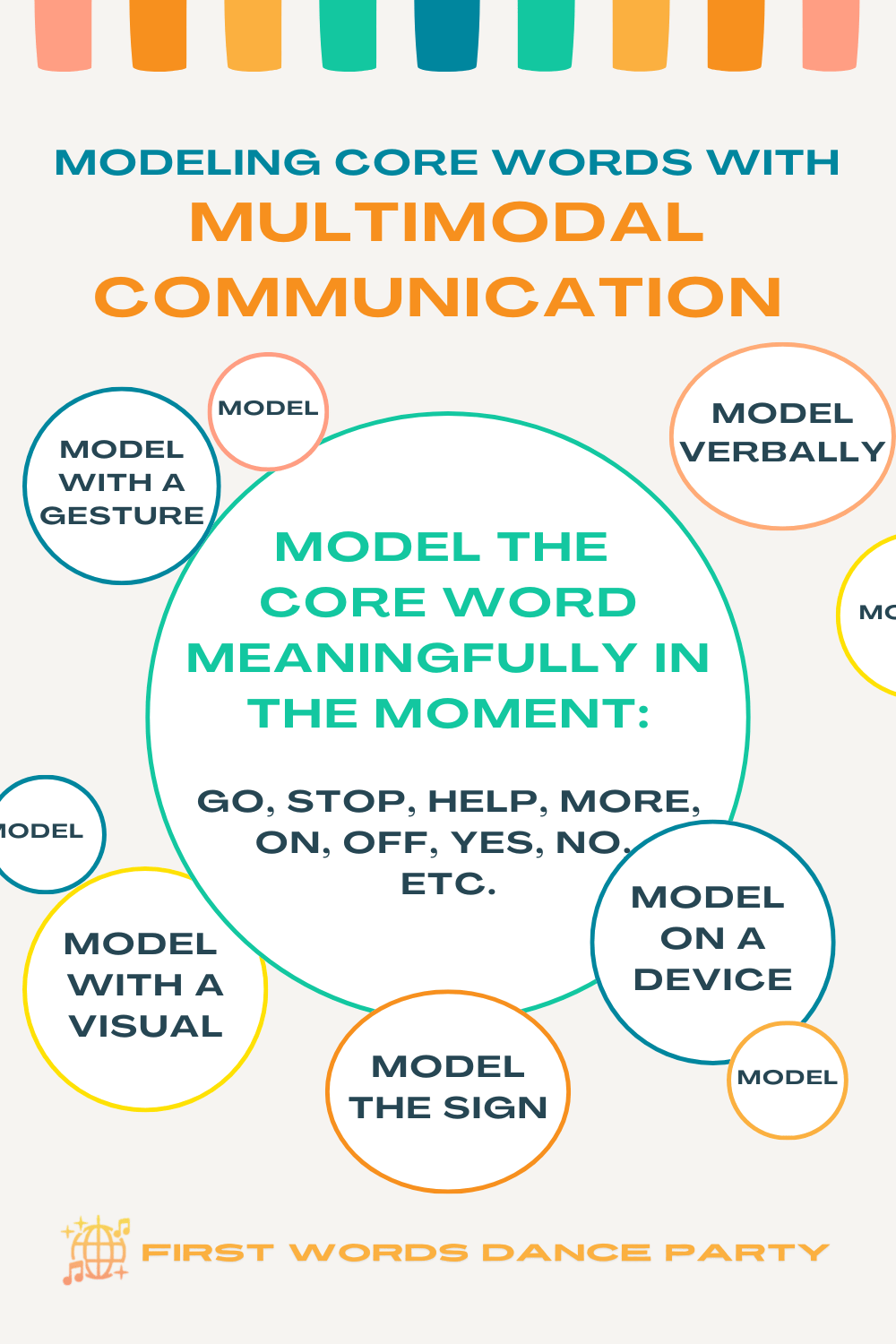
How to model core words for AAC users
If your child uses AAC, you can use aided language stimulation to model the core word on their device during the song. Want more support on using visuals and AAC to model language? This guide from Praactical AAC offers an overview of aided language input and total communication strategies with practical tips for getting started.

How to model core vocab for gestalt language processors
If your child communicates mostly with scripts (phrases they have echoed from songs, shows, and real-life situations), your kiddo may be a gestalt language processor. Gestalt language processing differs from the “standard” way of processing language in that gestalt language learners process language in whole chunks, rather than in individual words.
Since gestalt language processors naturally cue into the melody of language, modeling core words with music is a fabulous way to teach to their language learning style.
And because gestalt language processors use and understand words in phrases first before they understand the meanings of individual words, song lyrics are perfect for modeling core words.
You’ll just want to put your thoughtful pauses before the start of a phrase, rather than at the end of it, to invite your child to participate. This kind of pausing keeps the phrase, or script, whole for your kiddo who understands language in whole chunks.
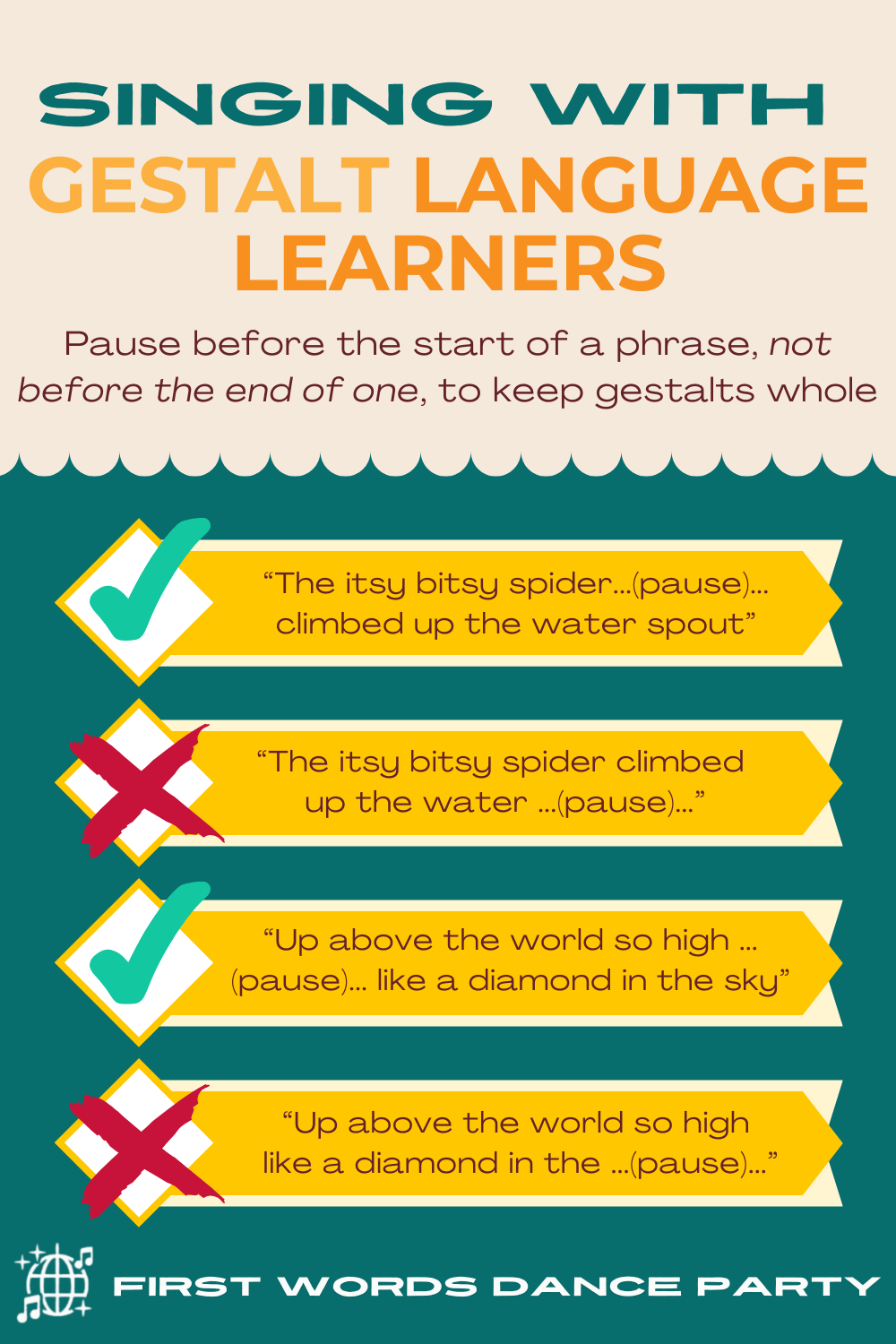
Wondering if your child is a gestalt language processor? You can check out the three-part series on supporting gestalt language processors for major results:
Is Your Child A Gestalt Language Processor? How to Know- and Why It Matters
The Gestalt Language Process: How to Use Music for Quick, Powerful Wins
Need a helping hand? The Homeschool Speech Therapy Handbook can help
If you’ve ever felt the weight of trying to support your child’s speech progress at home—wondering “Where do I even start?” or feeling like the things you have tried just haven’t been successful—you’re absolutely not alone. Trying to navigate speech therapy home activities that feel meaningful and manageable (rather than another exhausting to‑do) can leave you drained, second‑guessing, and wishing for something simpler.
That’s where the Homeschool Speech Therapy Handbook comes in. Designed specifically for parents (not trained therapists) who want real‑life tools, this guide breaks down exactly what to do, why it works, and how to bring speech‑therapy practice into everyday moments—snack time, bath time, play time—without turning your home into a clinic.
Framed within a song-by-song breakdown of the Speak up and Dance album, you’ll discover how to apply the strategies within each song to real life for easy speech therapy practice at home. You’ll move from feeling overwhelmed and unsure to feeling confident and connected—watching your child engage, communicate, and grow in ways that feel easy and natural.
You don’t need to be a speech therapist—you just need the right approach
Modeling core vocab doesn’t have to be complicated—and it definitely doesn’t require a degree. What it really takes is connection, repetition, and the willingness to slow down and model words in ways that feel natural and meaningful.
Music gives us a fun, brain-friendly way to repeat important words, build routines, and connect with our kids in a way they enjoy. Whether you’re singing Wheels on the Bus on your living room floor or listening and singing along to First Words Dance Party in the car, you’re doing powerful work.
Every time you intentionally model a word like go, more, or stop, you’re laying a foundation of language that is rich and deep. You’re helping your child to discover the power of their own voice as they express key concepts.
Before you go do another load of laundry or prep lunch, don't forget to grab your free 5 Easy Steps to Kickstart Communication with Music for Speech Therapy at Home to start connecting and communicating with your kiddo.
It may seem counterintuitive that these simple little words are the richest ones you can offer your child, but it’s the simple truth. Core vocab words are small but mighty for young language learners.
FAQ: Core Vocabulary for AAC Modeling and Music
What is core vocab?
Core vocabulary refers to the small set of high-frequency words that make up most of what we say every day—words like go, more, want, stop, and help. These words are useful across situations, and they’re a key part of how we help children build functional language skills.
What is aided language stimulation?
Aided language stimulation is when a communication partner models words, like core words, by pointing to them on an AAC system, core board, or visual while speaking. It teaches children how to use their AAC system to communicate. This article from AssistiveWare explains exactly how to incorporate it into your child’s daily routines in quick and easy ways.
My child has a speech delay. Can music really help them?
Yes! Music is rhythmic, repetitive, and emotionally engaging—making it a perfect vehicle for language learning. It naturally lends itself to AAC modeling, reinforcing core vocabulary in ways that feel playful and meaningful.
What is multi-modal communication?
Multi-modal communication simply means using more than one way to communicate. This might include speech, gestures, sign language, AAC devices, or visuals—all working together to support understanding and expression.
My child is minimally speaking and only says a couple of words. Are they too behind for this?
Not at all. In fact, core vocabulary is ideal for children who are just beginning to communicate. You can start modeling even if your child isn’t yet using words—they’re still learning through input.
Are core words AAC exclusive?
Nope! Core words are helpful for everyone. They are a central part of AAC systems, but they’re also essential for spoken language development and are used in aided language stimulation with or without a device.
What if my child is a gestalt language processor? Is core vocab a bad fit?
Not at all! Core words can be modeled within your child’s scripts or as part of a new script you choose to target. For example, intentionally modeling a script like “Ready… set… go!” or modeling “I like to eat apples and bananas” taps into your child’s learning style while also incorporating a core word you can “free” from the gestalt down the road.
Do I need a device to start modeling AAC core words?
Not at all. There are lots of ways to model without a device, such as:
Verbally saying key core words during daily activities
Using gestures or sign language to represent core words
Pointing to words on a printed core board or visual
Using real objects or toys to reinforce the meaning of core vocab words
